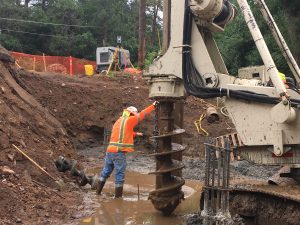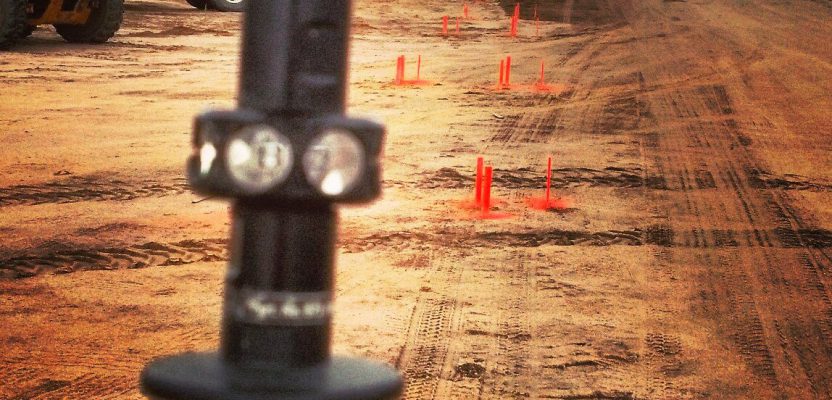Are you doing it right?
In today’s world, survey construction staking is a major service being provided by most companies within the land surveying and civil engineering industry. Throughout my career, like many of you, I have been employed by a handful of different land surveying and civil engineering firms, and with each firm came a different style of dedicated procedural standards, and/or, often, a different business model entirely.
My short decade or so of experience has been enough to allow me to identify what I believe to be the three most common, if not only, existing business models related to construction staking that I believe should be highlighted and openly discussed.
Here I review these business models, detail why the companies have chosen to implement them, and give you my personal conclusion as to which model is the best for the surveying profession and why.
Model #1: The Dummy Model
Model #1 is a business model that’s designed solely to protect the company from as much risk of error as possible.
Under this model, the company’s survey office personnel are responsible for any and all decisions regarding what is staked for construction in the field. They calculate (calc) the points or alignments that are to be staked in the field based upon the civil engineering or architectural design plans and review it with the field crews on the morning the field work is scheduled to be performed.
Typically the field crews will rely solely upon what was told to them by the office personnel and will never even open the construction plan sets in order to confirm that what they are staking is actually correct.
Per company policy, the field crews are only allowed to stake what is calc›d for them. If they run into a situation that they believe requires some sort of change or adjustment, they must call the office, explain the situation, and await approval before making any changes to the calcs.
The reason that I call this “the dummy model” is because it takes away all critical thinking from the party chief and/or field crews. The crews are not expected to make decisions and are forced to rely upon someone else to do what would normally be a major part of their responsibilities.
In my opinion, this type of policy creates more of the infamous “button pushers” and really puts a halt to the field crew’s career growth and skill development.
While I truly do feel this way, I also understand and appreciate why companies implement it into their practices. Without doing any research on the matter, I think it is safe to say that the leading cause of lawsuits or back-charges against a surveying firm is due to errors made related to the construction staking layout.
This particular business model just removes another layer of risk out of the company’s services, further protecting them from possible errors and costly mistakes. As most of us know, a mistake related to construction staking doesn’t have to be big for it to be expensive.
Model #2: We Are Not Engineers
Model #2 has a lot of similarity to but is very different from the first model.
In this model each and every party chief at the company is responsible for the stakes that they put into the ground.
While office personnel are still creating the calcs for staking construction projects, the field crews are responsible for ensuring to the best of their abilities that the calcs are correct. They are responsible for doing quick reviews of the applicable plan sheets as well as ensuring the proposed tie-in areas will fit existing field conditions (i.e. grading, existing manhole inverts, existing curb and gutter, etc.).
 Every field crew is mandated to have a set of the project construction plans with them at all times. The crews are considered to be the last line of defense for the company and are responsible for reviewing the plans prior to arriving on site. This ensures the crews become familiar with the proposed designs and helps to make any possible errors made by the office personnel more identifiable to the field crews.
Every field crew is mandated to have a set of the project construction plans with them at all times. The crews are considered to be the last line of defense for the company and are responsible for reviewing the plans prior to arriving on site. This ensures the crews become familiar with the proposed designs and helps to make any possible errors made by the office personnel more identifiable to the field crews.
Any time a field crew is staking points created by office personnel that are designed to tie into an existing structure, check shots are to be taken on the existing feature to ensure that the design elevations/locations match or tie-in correctly. If a discrepancy is found between the design location and the actual position, the party chief will contact the office and let them know of the issue.
Once the office personnel confirm that the issue does exist and that no documentation has been provided to them about a correction, they will place a call to the engineering firm to discuss. This is where I came up with model #2’s name, “We are not engineers.”
Although almost any party chief could fix many of these issues on the spot in the field, the company does not want to take on the risk of making a mistake or overlooking a specific detail that the engineers had in mind when creating their design. More important than the possibility of making errors is the ethical factor that surveyors have no right to adjust an engineer’s design without some kind of consent from them, just as no construction company has the right to change a surveyor’s stakes without the same.
If a surveyor does make an adjustment and it turns out to be wrong for any reason, the cost associated with fixing what has been constructed based on the survey stakes in the field will fall on the surveyors, and the company will be held liable.
Model #3: Make It Work
Model #3 is essentially the same as model #2 minus the engineering license concerns.
The priority of this business model is to keep construction projects moving forward, thus keeping the clients satisfied and happy.
An owner or manager of a surveying firm who implements this particular model wants the party chief on site to make the decision themselves should some kind of issue arise between design and reality. If the party chief can make a decision to adjust a design in order to keep the project moving forward without issue—and the risks are minimal—then the party chief should do so on their own.
This practice, when done correctly, can actually be quite successful. Clientele begin to feel confident with the survey work being performed and they begin to notice that they rarely have to deal with delays or problems that otherwise normally arise.
When no mistakes are made, all parties involved (engineers, surveyors, contractors) remain happy and in good spirits because things run smoothly.
However, when the party chief is wrong, you better believe that the surveying company is going to incur all of the costs that arise because of it.
While I understand the reasoning behind this particular business model, I can’t help but question some of the professional ethics behind it as well as the risk-versus-reward balancing act in the long run.
What’s Best?
All three business models have advantages and disadvantages to the others, and each may work better for one company’s operations over another’s. I am sure that your own experiences may differ from mine and that your opinions may also do the same, but please keep in mind that my intent is only to convey to you which model I believe is best, not for a company, but for the surveying profession as a whole.
Model #2, “We are not engineers,” is what I believe to be the best model for our profession. It helps ensure that our younger generations of surveyors know how to take responsibility for the work that they perform while also teaching them what actions and liabilities may be out of a surveyor’s professional purview. Over time, they learn how to run a project from start to finish and how to perform under pressure from clients, contractors, deadlines, and engineers.
This model is the key to building a stronger generation of future professionals and solidifying a sturdy foundation of principles within them.
From a business standpoint, I believe that mistakes will be made; it is simply inevitable. However, maintaining a near-flawless balance between limiting risk and building the best new generation of professionals should be a goal of every company and every surveyor. I believe that model #2 will yield you the best return on the major investment you have made (and continue to make) in your business and in your employees.

